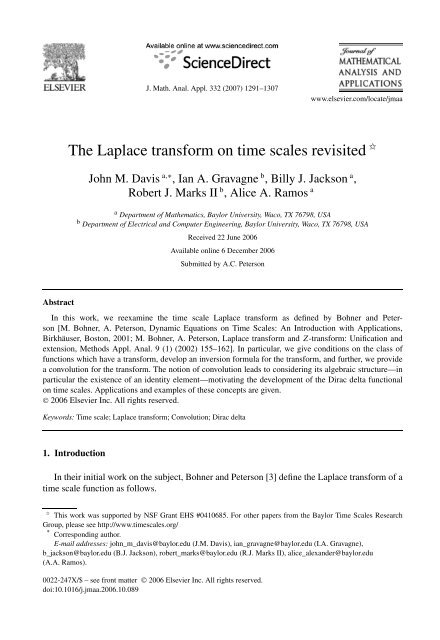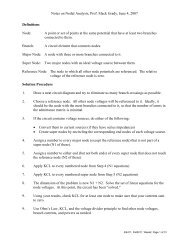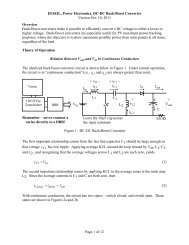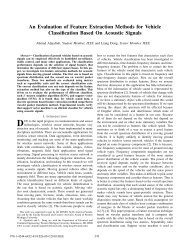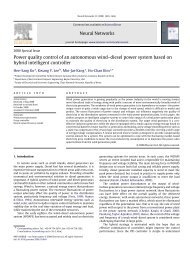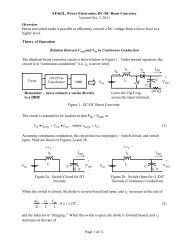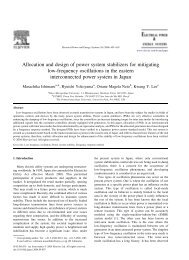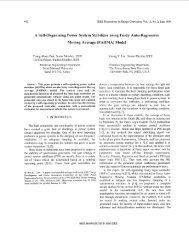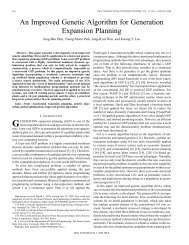The Laplace transform on time scales revisited - ECS - Baylor ...
The Laplace transform on time scales revisited - ECS - Baylor ...
The Laplace transform on time scales revisited - ECS - Baylor ...
Create successful ePaper yourself
Turn your PDF publications into a flip-book with our unique Google optimized e-Paper software.
J. Math. Anal. Appl. 332 (2007) 1291–1307www.elsevier.com/locate/jmaa<str<strong>on</strong>g>The</str<strong>on</strong>g> <str<strong>on</strong>g>Laplace</str<strong>on</strong>g> <str<strong>on</strong>g>transform</str<strong>on</strong>g> <strong>on</strong> <strong>time</strong> <strong>scales</strong> <strong>revisited</strong> ✩John M. Davis a,∗ , Ian A. Gravagne b , Billy J. Jacks<strong>on</strong> a ,Robert J. Marks II b , Alice A. Ramos aa Department of Mathematics, <strong>Baylor</strong> University, Waco, TX 76798, USAb Department of Electrical and Computer Engineering, <strong>Baylor</strong> University, Waco, TX 76798, USAReceived 22 June 2006Available <strong>on</strong>line 6 December 2006Submitted by A.C. Peters<strong>on</strong>AbstractIn this work, we reexamine the <strong>time</strong> scale <str<strong>on</strong>g>Laplace</str<strong>on</strong>g> <str<strong>on</strong>g>transform</str<strong>on</strong>g> as defined by Bohner and Peters<strong>on</strong>[M. Bohner, A. Peters<strong>on</strong>, Dynamic Equati<strong>on</strong>s <strong>on</strong> Time Scales: An Introducti<strong>on</strong> with Applicati<strong>on</strong>s,Birkhäuser, Bost<strong>on</strong>, 2001; M. Bohner, A. Peters<strong>on</strong>, <str<strong>on</strong>g>Laplace</str<strong>on</strong>g> <str<strong>on</strong>g>transform</str<strong>on</strong>g> and Z-<str<strong>on</strong>g>transform</str<strong>on</strong>g>: Unificati<strong>on</strong> andextensi<strong>on</strong>, Methods Appl. Anal. 9 (1) (2002) 155–162]. In particular, we give c<strong>on</strong>diti<strong>on</strong>s <strong>on</strong> the class offuncti<strong>on</strong>s which have a <str<strong>on</strong>g>transform</str<strong>on</strong>g>, develop an inversi<strong>on</strong> formula for the <str<strong>on</strong>g>transform</str<strong>on</strong>g>, and further, we providea c<strong>on</strong>voluti<strong>on</strong> for the <str<strong>on</strong>g>transform</str<strong>on</strong>g>. <str<strong>on</strong>g>The</str<strong>on</strong>g> noti<strong>on</strong> of c<strong>on</strong>voluti<strong>on</strong> leads to c<strong>on</strong>sidering its algebraic structure—inparticular the existence of an identity element—motivating the development of the Dirac delta functi<strong>on</strong>al<strong>on</strong> <strong>time</strong> <strong>scales</strong>. Applicati<strong>on</strong>s and examples of these c<strong>on</strong>cepts are given.© 2006 Elsevier Inc. All rights reserved.Keywords: Time scale; <str<strong>on</strong>g>Laplace</str<strong>on</strong>g> <str<strong>on</strong>g>transform</str<strong>on</strong>g>; C<strong>on</strong>voluti<strong>on</strong>; Dirac delta1. Introducti<strong>on</strong>In their initial work <strong>on</strong> the subject, Bohner and Peters<strong>on</strong> [3] define the <str<strong>on</strong>g>Laplace</str<strong>on</strong>g> <str<strong>on</strong>g>transform</str<strong>on</strong>g> of a<strong>time</strong> scale functi<strong>on</strong> as follows.✩This work was supported by NSF Grant EHS #0410685. For other papers from the <strong>Baylor</strong> Time Scales ResearchGroup, please see http://www.<strong>time</strong><strong>scales</strong>.org/* Corresp<strong>on</strong>ding author.E-mail addresses: john_m_davis@baylor.edu (J.M. Davis), ian_gravagne@baylor.edu (I.A. Gravagne),b_jacks<strong>on</strong>@baylor.edu (B.J. Jacks<strong>on</strong>), robert_marks@baylor.edu (R.J. Marks II), alice_alexander@baylor.edu(A.A. Ramos).0022-247X/$ – see fr<strong>on</strong>t matter © 2006 Elsevier Inc. All rights reserved.doi:10.1016/j.jmaa.2006.10.089
1292 J.M. Davis et al. / J. Math. Anal. Appl. 332 (2007) 1291–1307Definiti<strong>on</strong> 1.1. For f : T → R,the<strong>time</strong> scale or generalized <str<strong>on</strong>g>Laplace</str<strong>on</strong>g> <str<strong>on</strong>g>transform</str<strong>on</strong>g> of f , denoted byL{f } or F(z), is given byL{f }(z) = F(z):=where g(t) = e ⊖z (t, 0).∫ ∞0f(t)g σ (t) t, (1.1)<str<strong>on</strong>g>The</str<strong>on</strong>g>y go <strong>on</strong> to state that the <str<strong>on</strong>g>transform</str<strong>on</strong>g> is defined for some appropriate collecti<strong>on</strong> of complexnumbers z ∈ C for which the integral c<strong>on</strong>verges, but give no inversi<strong>on</strong> formula for the <str<strong>on</strong>g>transform</str<strong>on</strong>g>.Instead, they give the <str<strong>on</strong>g>transform</str<strong>on</strong>g> of the elementary functi<strong>on</strong>s and show the uniqueness of their<str<strong>on</strong>g>transform</str<strong>on</strong>g>s by using the uniqueness of soluti<strong>on</strong>s to ordinary dynamic equati<strong>on</strong>s.<str<strong>on</strong>g>The</str<strong>on</strong>g> goal of this paper is first to quantify a subset of the complex plane for which the integralc<strong>on</strong>verges; that is, establish a regi<strong>on</strong> of c<strong>on</strong>vergence in the complex plane for (1.1). Furthermore,we provide a relatively simple inversi<strong>on</strong> formula and show that inverses are uniquely determinedby it. Finally, a noti<strong>on</strong> of c<strong>on</strong>voluti<strong>on</strong> arises and its algebraic structure is explored. Inthis process, the identity element is determined to be the appropriate analogue of the Dirac deltafuncti<strong>on</strong>al.Definiti<strong>on</strong> 1.2. <str<strong>on</strong>g>The</str<strong>on</strong>g> functi<strong>on</strong> f : T → R is said to be of exp<strong>on</strong>ential type I if there exist c<strong>on</strong>stantsM,c > 0 such that |f(t)| Me ct . Furthermore, f is said to be of exp<strong>on</strong>ential type II if thereexist c<strong>on</strong>stants M,c > 0 such that |f(t)| Me c (t, 0).<str<strong>on</strong>g>The</str<strong>on</strong>g> <strong>time</strong> scale exp<strong>on</strong>ential functi<strong>on</strong> itself is of type II. In their work <strong>on</strong> the stability of the<strong>time</strong> scale exp<strong>on</strong>ential functi<strong>on</strong>, Pötzsche, Siegmund, and Wirth [6] show that the <strong>time</strong> scalepolynomials h k (t, 0) are of type I.Throughout this work, we will assume that T is a <strong>time</strong> scale with bounded graininess, thatis, 0
J.M. Davis et al. / J. Math. Anal. Appl. 332 (2007) 1291–1307 1293Fig. 2. <str<strong>on</strong>g>The</str<strong>on</strong>g> regi<strong>on</strong> of c<strong>on</strong>vergence is shaded. On the left, the μ ∗ = 0 case. On the right, the μ ∗ ≠ 0 case. In the latter,note our proof of the inversi<strong>on</strong> formula is <strong>on</strong>ly valid for Re z>c, i.e., the right half plane bounded by this abscissa ofc<strong>on</strong>vergence even though the regi<strong>on</strong> of c<strong>on</strong>vergence is clearly a superset of this right half plane.we obtain lim t→∞ e λ (t, 0) = 0. See Fig. 1. This limit c<strong>on</strong>diti<strong>on</strong> will play a crucial role in theanalysis of the <str<strong>on</strong>g>transform</str<strong>on</strong>g>. However, the expressi<strong>on</strong> for the <str<strong>on</strong>g>transform</str<strong>on</strong>g> has a slight complicati<strong>on</strong>since the functi<strong>on</strong> ⊖z is <strong>time</strong> varying and not c<strong>on</strong>stant. Fortunately, this is <strong>on</strong>ly a minor problemto overcome as we shall see.To give an appropriate domain for the <str<strong>on</strong>g>transform</str<strong>on</strong>g>, which of course is tied to the regi<strong>on</strong> ofc<strong>on</strong>vergence of the integral in (1.1), for any c>0 define the setD := { z ∈ C: Re μ (z) > Re μ (c) for all t ∈ T }= { z ∈ C: z ∈ H ∁ max and z satisfies Re μ ∗(z) > Re μ∗ (c) }= { z ∈ C: ⊖z ∈ H and Re μ (z) > Re μ (c) for all t ∈ T } ,where H ∁ max denotes the complement of the closure of largest Hilger circle corresp<strong>on</strong>ding to μ ∗.Note that if μ ∗ = 0 this set is a right half plane; see Fig. 2.Furthermore, if z ∈ D, then ⊖z ∈ H min ⊂ H t since for all z ∈ D, ⊖z satisfies the inequality∣ ⊖z + 1 ∣ ∣∣∣μ ∗ < 1 μ ∗ .Finally, if Re μ∗ (z) > Re μ∗ (c), then Re μ (z) > Re μ (c) for all t ∈ T since the Hilger real part is anincreasing functi<strong>on</strong> in μ. This observati<strong>on</strong> will play a key role later.Lemma 1.1. If ⊖z ∈ H and Re μ (z) > Re μ (c), then ((⊖z) ⊕ c) ∈ H.Proof. Since Re μ (z) > Re μ (c) implies |1 + zμ(t)| > |1 + cμ(t)|, we see∣ 1∣∣∣∣ (⊖z ⊕ c) + μ(t) ∣ = 1 + cμ(t)μ(t)(1 + zμ(t)) ∣ = |1 + cμ(t)|μ(t)|1 + zμ(t)| < 1μ(t) .✷<str<strong>on</strong>g>The</str<strong>on</strong>g>orem 1.1 (Domain of the <str<strong>on</strong>g>transform</str<strong>on</strong>g>). <str<strong>on</strong>g>The</str<strong>on</strong>g> integral ∫ ∞0e⊖z σ (t, 0)f (t) t c<strong>on</strong>verges absolutelyfor z ∈ D if f(t)is of exp<strong>on</strong>ential type II with exp<strong>on</strong>ential c<strong>on</strong>stant c.Proof. If ⊖z ∈ H, then1|1+zμ(t)| 1. Thus,
1294 J.M. Davis et al. / J. Math. Anal. Appl. 332 (2007) 1291–1307∣∫ ∞0e σ ⊖z (t, 0)f (t) t ∣ ∣∣∣∣∫ ∞0 M M= M= M M∣∣e⊖z σ (t, 0)f (t)∣ ∣ t∫ ∞0∫ ∞0∫ ∞0∫ ∞0∫ ∞0= M α ,wherelog ∣ 1+μ ∗c ∣∣ α =1+μ ∗ z ∣∣∣∣ μ ∗ . ✷1∣∣1 + zμ(t) ∣ e⊖z (t, 0)e c (t, 0) ∣ t∣ e⊖z⊕c (t, 0) ∣ texpexp( ∫t0( ∫t0e −αt dtlog |1 + μ(τ)(⊖z ⊕ c)|μ(τ)log ∣ 1+μ(τ)c)∣1+μ(τ)zτ tμ(τ))τ t<str<strong>on</strong>g>The</str<strong>on</strong>g> same estimates used in the proof of the preceding theorem can be used to show that if f(t)is of exp<strong>on</strong>ential type II with c<strong>on</strong>stant c and Re μ (z) > Re μ (c), then lim t→∞ e ⊖z (t, 0)f (t) = 0.1.1. Properties of the <str<strong>on</strong>g>transform</str<strong>on</strong>g>As we look towards an inverse for the <str<strong>on</strong>g>transform</str<strong>on</strong>g>, we would like to know which functi<strong>on</strong>sare the <str<strong>on</strong>g>transform</str<strong>on</strong>g> of some functi<strong>on</strong>. To answer this questi<strong>on</strong>, the following properties areneeded.<str<strong>on</strong>g>The</str<strong>on</strong>g>orem 1.2. Let F denote the generalized <str<strong>on</strong>g>Laplace</str<strong>on</strong>g> <str<strong>on</strong>g>transform</str<strong>on</strong>g> for f : T → R.(1) F(z)is analytic in Re μ (z) > Re μ (c).(2) F(z)is bounded in Re μ (z) > Re μ (c).(3) lim |z|→∞ F(z)= 0.
J.M. Davis et al. / J. Math. Anal. Appl. 332 (2007) 1291–1307 1295Proof. For the first, we seeddz L{f }(z) = d dz∫ ∞0∫ ∞d=dz=0∫ ∞ ( ∫t0 0∫ ∞ ( ∫σ(t)=−0e⊖z σ (t, 0)f (t) t(∫0( t11 + μ(t)z explog ( ) ))11+μ(τ)zτ f(t)tμ(τ))−1μ(t)τ − e⊖z σ (t, 0)f (t) t1 + μ(τ)z 1 + μ(t)z0=−L{gf }(z),)11 + μ(τ)z τ e⊖z σ (t, 0)f (t) twhere g(t) = ∫ σ(t) 10 1+μ(τ)zτ . <str<strong>on</strong>g>The</str<strong>on</strong>g> sec<strong>on</strong>d equality follows from the Lebesgue DominatedC<strong>on</strong>vergence <str<strong>on</strong>g>The</str<strong>on</strong>g>orem. <str<strong>on</strong>g>The</str<strong>on</strong>g>se calculati<strong>on</strong>s show we get the familiar formula when T = R thatderivatives of the <str<strong>on</strong>g>transform</str<strong>on</strong>g> corresp<strong>on</strong>d to multiplicati<strong>on</strong> by powers of t in the functi<strong>on</strong>. ForT = Z, the calculati<strong>on</strong>s show that (in the shifted versi<strong>on</strong>) derivatives of the <str<strong>on</strong>g>transform</str<strong>on</strong>g> corresp<strong>on</strong>dto multiplicati<strong>on</strong> by powers of t + 1 in the functi<strong>on</strong>.<str<strong>on</strong>g>The</str<strong>on</strong>g> sec<strong>on</strong>d claim is an immediate c<strong>on</strong>sequence of the preceding theorem since it shows|F(z)| < M α .As for the third, a direct calculati<strong>on</strong> yieldslim F(z)= lim|z|→∞∫ ∞|z|→∞0∫∞e⊖z σ (t, 0)f (t) t = lim|z|→∞ eσ ⊖z (t, 0)f (t) t = 0. ✷<str<strong>on</strong>g>The</str<strong>on</strong>g>orem 1.3 (Initial and final values). Let f : T → R have generalized <str<strong>on</strong>g>Laplace</str<strong>on</strong>g> <str<strong>on</strong>g>transform</str<strong>on</strong>g> F(z).<str<strong>on</strong>g>The</str<strong>on</strong>g>n f(0) = lim z→∞ zF (z) and lim t→∞ f(t)= lim z→0 zF (z) when the limits exist.Proof.L { f (t) } =∫ ∞0f (t)e⊖z σ (t, 0)t= f(t)e ⊖z (t, 0) ∣ ∫∞∞ t=0 − f(t)(⊖z)(t)e ⊖z (t, 0)t=−f(0) + z∫ ∞0= zF (z) − f(0).00f(t)e⊖z σ (t, 0)t
1296 J.M. Davis et al. / J. Math. Anal. Appl. 332 (2007) 1291–1307Now z →∞above yieldslim∫ ∞z→∞0f (t)e⊖z σ [ ](t, 0)t = 0 = lim zF (z) − f(0) ,z→∞i.e., f(0) = lim z→∞ zF (z).On the other hand, z → 0 yieldslim∫ ∞z→00∫∞f (t)e⊖z σ (t, 0)t =i.e., lim t→∞ f(t)= lim z→0 zF (z).1.2. Inversi<strong>on</strong> formula0f (t) t = limt→∞✷[ ]f(t)− f(0) = lim zF (z) − f(0) ,z→0Using <str<strong>on</strong>g>The</str<strong>on</strong>g>orem 1.2 we can establish an inversi<strong>on</strong> formula for the <str<strong>on</strong>g>transform</str<strong>on</strong>g>. As is the casewith T = R, these properties are not sufficient to guarantee that F(z) is the <str<strong>on</strong>g>transform</str<strong>on</strong>g> of somec<strong>on</strong>tinuous functi<strong>on</strong> f(t), but they are necessary as we have just seen. For sufficiency, we havethe following:<str<strong>on</strong>g>The</str<strong>on</strong>g>orem 1.4 (Inversi<strong>on</strong> of the <str<strong>on</strong>g>transform</str<strong>on</strong>g>). Suppose that F(z) is analytic in the regi<strong>on</strong> Re μ (z) >Re μ (c) and F(z) → 0 uniformly as |z| →∞in this regi<strong>on</strong>. Suppose F(z) has finitely manyregressive poles of finite order {z 1 ,z 2 ,...,z n } and ˜F R (z) is the <str<strong>on</strong>g>transform</str<strong>on</strong>g> of the functi<strong>on</strong> f(t) ˜<strong>on</strong> R that corresp<strong>on</strong>ds to the <str<strong>on</strong>g>transform</str<strong>on</strong>g> F(z)= F T (z) of f(t)<strong>on</strong> T.Ifthen∫c+i∞c−i∞f(t)=∣ ˜F R (z) ∣ |dz| < ∞,n∑Res z=zi e z (t, 0)F (z),i=1has <str<strong>on</strong>g>transform</str<strong>on</strong>g> F(z)for all z with Re(z) > c.Proof. <str<strong>on</strong>g>The</str<strong>on</strong>g> proof follows from the commutative diagram between the appropriate functi<strong>on</strong>spaces in Fig. 3.Let C be the collecti<strong>on</strong> of <str<strong>on</strong>g>Laplace</str<strong>on</strong>g> <str<strong>on</strong>g>transform</str<strong>on</strong>g>s over R, and D the collecti<strong>on</strong> of <str<strong>on</strong>g>transform</str<strong>on</strong>g>sover T, i.e., C ={˜F R (z)} and D ={F T (z)}, where ˜F R (z) = G(z)e −zτ and F T (z) = G(z)e ⊖z (τ, 0)C p-eo (R, R) θ θ −1C prd-e2 (T, R) L −1TL RL −1RCγL T D= θ ◦ L−1 R ◦ γ −1γ −1Fig. 3. Commutative diagram between the functi<strong>on</strong> spaces.
J.M. Davis et al. / J. Math. Anal. Appl. 332 (2007) 1291–1307 1297for G a rati<strong>on</strong>al functi<strong>on</strong> and for τ ∈ T a c<strong>on</strong>stant. Let C p-eo (R, R) denote the space of piecewisec<strong>on</strong>tinuous functi<strong>on</strong>s of exp<strong>on</strong>ential order, and C prd-e2 (T, R) denote the space of piecewise rightdensec<strong>on</strong>tinuous functi<strong>on</strong>s of exp<strong>on</strong>ential type II.Each of θ, γ , θ −1 , γ −1 maps functi<strong>on</strong>s involving the c<strong>on</strong>tinuous exp<strong>on</strong>ential to the <strong>time</strong>scale exp<strong>on</strong>ential and vice versa. For example, γ maps the functi<strong>on</strong> ˜F(z)= e−zazto the functi<strong>on</strong>F(z)= e ⊖z(a,0)z, while γ −1 maps F(z)back to ˜F(z)in the obvious manner. If the representati<strong>on</strong>of F(z) is independent of the exp<strong>on</strong>ential (that is, τ = 0), then γ and its inverse will act as theidentity. For example,( 1γz 2 + 1)= γ −1 ( 1z 2 + 1)= 1z 2 + 1 .θ will send the c<strong>on</strong>tinuous exp<strong>on</strong>ential functi<strong>on</strong> to the <strong>time</strong> scale exp<strong>on</strong>ential functi<strong>on</strong> in thefollowing manner: if we write f(t)∈ ˜ C p-eo (R, R) asthen˜ f(t)=n∑Res z=zi e zt ˜F R (z),i=1θ ( ˜ f(t) ) =n∑Res z=zi e z (t, 0)F T (z).i=1To go from ˜F R (z) to F T (z), we simply switch expressi<strong>on</strong>s involving the c<strong>on</strong>tinuous exp<strong>on</strong>entialin ˜F R (z) with the <strong>time</strong> scale exp<strong>on</strong>ential giving F T (z) as was d<strong>on</strong>e for γ and its inverse. θ −1 willthen act <strong>on</strong> g ∈ C prd-e2 (T, R),n∑g(t) = Res z=zi e z (t, 0)G T (z),asi=1θ −1( g(t) ) =n∑Res z=zi e zt ˜G R (z).i=1For example, for the unit step functi<strong>on</strong> ũ a (t) <strong>on</strong> R, we know from the c<strong>on</strong>tinuous result that wemay write the step functi<strong>on</strong> asũ a (t) = Res z=0 e zt · e−azz ,so that if a ∈ T, thenθ ( ũ a (t) ) = Res z=0 e z (t, 0) e ⊖z(a, 0).zWith these operators defined <strong>on</strong> these spaces, we can see that the claim in the theorem follows.For a given <strong>time</strong> scale <str<strong>on</strong>g>Laplace</str<strong>on</strong>g> <str<strong>on</strong>g>transform</str<strong>on</strong>g> F T (z), we begin by mapping to ˜F R (z) via γ −1 .<str<strong>on</strong>g>The</str<strong>on</strong>g>hypotheses <strong>on</strong> F T (z) and ˜F R (z) are enough to guarantee the inverse of ˜F R (z) exists for all z withRe(z) > c (see [1]), and is given by˜ f(t)=n∑Res z=zi e zt ˜F R (z).i=1
1298 J.M. Davis et al. / J. Math. Anal. Appl. 332 (2007) 1291–1307Apply θ to f(t)to ˜ retrieve the <strong>time</strong> scale functi<strong>on</strong>n∑f(t)= Res z=zi e z (t, 0)F T (z),i=1whereby (γ ◦ L R ◦ θ −1 )(f (t)) = F T (z) as claimed.✷Before looking at a few examples, some remarks are in order. First, it is reas<strong>on</strong>able to ask ifthere is a c<strong>on</strong>tour in the complex plane around which it is possible to integrate to obtain the sameresults that we have obtained here through a more operati<strong>on</strong>al approach. At present, we leavethis as a very interesting although n<strong>on</strong>trivial open problem. It is well known that there are suchc<strong>on</strong>tours when T = R or T = Z. In fact, it can easily be shown that if T is completely discrete,then if we choose any circle in the regi<strong>on</strong> of c<strong>on</strong>vergence which encloses all of the singularitiesof F(z), we will obtain the inversi<strong>on</strong> formula. However, in general, we do not know whether ornot there exists a c<strong>on</strong>tour which gives the formula, and if so, what it is.Sec<strong>on</strong>d, it is possible to use the technique we have presented here to define and find inversesfor any <strong>time</strong> scale <str<strong>on</strong>g>transform</str<strong>on</strong>g>. <str<strong>on</strong>g>The</str<strong>on</strong>g>se would include the Fourier, Mellin, and many other <str<strong>on</strong>g>transform</str<strong>on</strong>g>s.Once the inverse is known for T = R and the appropriate <strong>time</strong> scale integral is developedto give the correct <str<strong>on</strong>g>transform</str<strong>on</strong>g> analogues for any T, the diagram becomes completed and the inversi<strong>on</strong>formula for any T is readily obtained.Finally, notice in our c<strong>on</strong>structi<strong>on</strong>, for any <str<strong>on</strong>g>transform</str<strong>on</strong>g>able functi<strong>on</strong> f(t)<strong>on</strong> T, there is a shadowfuncti<strong>on</strong> f(t) ˜ defined <strong>on</strong> R. That is, to determine the appropriate <strong>time</strong> scale analogue of thefuncti<strong>on</strong> f(t) ˜ in terms of the <str<strong>on</strong>g>transform</str<strong>on</strong>g>, we use the diagram to map its <str<strong>on</strong>g>Laplace</str<strong>on</strong>g> <str<strong>on</strong>g>transform</str<strong>on</strong>g> <strong>on</strong> Rto its <str<strong>on</strong>g>Laplace</str<strong>on</strong>g> <str<strong>on</strong>g>transform</str<strong>on</strong>g> <strong>on</strong> T.Example 1.1 (New representati<strong>on</strong> for h k (t, 0)). Suppose F(z)= 1 . <str<strong>on</strong>g>The</str<strong>on</strong>g> hypotheses of <str<strong>on</strong>g>The</str<strong>on</strong>g>orem1.4 for F(z)are readily verified, so that F(z)has an inverse given 2 byzL −1 e z (t, 0){F }=f(t)= Res z=0z 2 = t.For F(z)= 1 ,wehavez 3L −1 e z (t, 0){F }=f(t)= Res z=0z 3 = t2 − ∫ t0μ(τ) τ= h 2 (t, 0).2<str<strong>on</strong>g>The</str<strong>on</strong>g> last equality is justified since the functi<strong>on</strong>f(t)= t2 − ∫ t0μ(τ) τ,2is the unique soluti<strong>on</strong> to the initial value problem f (t) = h 1 (t, 0), f(0) = 0. In a similar manner,we can use an inducti<strong>on</strong> argument coupled with <str<strong>on</strong>g>The</str<strong>on</strong>g>orem 1.4 to show that the inverse<str<strong>on</strong>g>transform</str<strong>on</strong>g> of F(z) = 1 ,fork a positive integer, is hz k+1 k (t, 0). In fact, it is easy to show thatthe inversi<strong>on</strong> formula gives the claimed inverses for any of the elementary functi<strong>on</strong>s that Bohnerand Peters<strong>on</strong> have in their table in [3]. <str<strong>on</strong>g>The</str<strong>on</strong>g>se elementary functi<strong>on</strong>s become the proper <strong>time</strong> scaleanalogues or shadows of their c<strong>on</strong>tinuous counterparts.Example 1.2. Suppose we would like to determine the appropriate shadow of the functi<strong>on</strong>f(t)= ˜1 t sin at, a > 0,2a
J.M. Davis et al. / J. Math. Anal. Appl. 332 (2007) 1291–1307 1299defined <strong>on</strong> T = R. At first glance, a reas<strong>on</strong>able c<strong>on</strong>jecture for its <strong>time</strong> scale analogue might bethe functi<strong>on</strong>f(t)= 12a h 1(t, 0) sin a (t, 0).However, closer inspecti<strong>on</strong> shows that this is incorrect. To see this, note that the <str<strong>on</strong>g>Laplace</str<strong>on</strong>g> <str<strong>on</strong>g>transform</str<strong>on</strong>g>of f(t)is ˜z˜F(z)=(z 2 + a 2 ) 2 .To find the proper analogue f(t) of f(t), ˜ we search for a <strong>time</strong> scale functi<strong>on</strong> with the same<str<strong>on</strong>g>transform</str<strong>on</strong>g> as f(t). ˜ To do this, we note thatf(t)= L −1 {F{}}= L −1 z(z 2 + a 2 ) 2=2∑i=1Res z=zize z (t, 0)(z 2 + a 2 ) 2= 12a sin a(t, 0)∫ t011 + (μ(τ)a) 2 τ − 1 ∫ t2 cos a(t, 0)0μ(τ)1 + (μ(τ)a) 2 τ,so that in general the correct analogue involves the <strong>time</strong> scale cosine functi<strong>on</strong> as well.Example 1.3. A useful <str<strong>on</strong>g>Laplace</str<strong>on</strong>g> <str<strong>on</strong>g>transform</str<strong>on</strong>g> property is the ability to compute the matrix exp<strong>on</strong>entiale A (t, 0) when A is a c<strong>on</strong>stant matrix. As in the discrete and c<strong>on</strong>tinuous cases, e A (t, 0) solvesthe initial value problem Y = AY , Y(0) = I . Transforming yields zL{Y }−Y(0) = AL{Y }, sothat L{Y }=(zI − A) −1 , or equivalently Y = e A (t, 0) = L −1 {(zI − A) −1 }.For example, let A = [ 2103]. <str<strong>on</strong>g>The</str<strong>on</strong>g>n[ 1(z−2)]1(zI − A) −1 (z−2)(z−3)=,10(z−3)so that[e2 (t, 0) e 3 (t, 0) − e 2 (t, 0)e A (t, 0) =0 e 3 (t, 0)].Example 1.4. C<strong>on</strong>sider the functi<strong>on</strong> F(z)= e ⊖z (σ (a), 0). This functi<strong>on</strong> has no regressive poles,and hence <str<strong>on</strong>g>The</str<strong>on</strong>g>orem 1.4 cannot be applied. If a is right scattered, <strong>on</strong>e can verify that the HilgerDelta functi<strong>on</strong> which has representati<strong>on</strong>{ 1δa H (t) = μ(a) , t = a,0, t ≠ a,has F(z) as a <str<strong>on</strong>g>transform</str<strong>on</strong>g>, while if a is right dense, the Dirac delta functi<strong>on</strong>al has F(z) as a<str<strong>on</strong>g>transform</str<strong>on</strong>g> as we shall see later.
1300 J.M. Davis et al. / J. Math. Anal. Appl. 332 (2007) 1291–13071.3. Uniqueness of the inverseIf two functi<strong>on</strong>s f and g have the same <str<strong>on</strong>g>transform</str<strong>on</strong>g>, then are f and g necessarily the samefuncti<strong>on</strong>? As <strong>on</strong> R, the answer to this questi<strong>on</strong> is affirmative if we define our equality in analmost everywhere (a.e.) sense. In order to do so, however, we must clarify what is meant by a.e.<strong>on</strong> a <strong>time</strong> scale.In his initial work <strong>on</strong> the <strong>time</strong> scale Lebesgue integral, Guseinov [5] defines the Carathéodoryextensi<strong>on</strong> of the set functi<strong>on</strong> that assigns each <strong>time</strong> scale interval its length to be the Lebesgue-measure <strong>on</strong> T. To c<strong>on</strong>struct his outer measure, Guseinov does a Vitali covering of subsets ofT by finite or countable systems of intervals of T, and then naturally defines the outer measureto be the infimum of the sums of the lengths of the intervals that cover the subsets. If there isno such covering, he defines the outer measure of the set to be infinite. As a c<strong>on</strong>sequence of thisdefiniti<strong>on</strong>, any <strong>time</strong> scale will have infinite -measure.However, Guseinov points out that his choosing the -measure to be infinite is merely topreserve the m<strong>on</strong>ot<strong>on</strong>icity of the outer measure. <str<strong>on</strong>g>The</str<strong>on</strong>g> m<strong>on</strong>ot<strong>on</strong>icity will also be preserved if for asubset E of T that cannot be covered, we define the outer measure of E to be the outer measureof the maximal coverable subset of E, call it F , plus some positive extended real number cchosen independently of E. For his purposes, Guseinov chooses c =∞, but for our purposes, itis c<strong>on</strong>venient to choose c = 0.By doing this, the Lebesgue -measure μ can be decomposed nicely. For any subset E of T,decompose E as E = D ∪ S, whereD ={t ∈ T: t is right dense}, S ={t ∈ T: t is right scattered}.Since c = 0 above, we may writeμ (E) = m(E ∩ D) + c(E ∩ S),where m(D) denotes the usual Lebesgue measure of the set D and c(S) is the measure given byc(S) = ∑ s∈S μ(s).Notice that with this decompositi<strong>on</strong>, the sets of measure zero can <strong>on</strong>ly c<strong>on</strong>sist of right densepoints since μ (E) = 0 if and <strong>on</strong>ly if m(E ∩D) = 0 and E ∩S =∅. Thus, to show that a propertyholds almost everywhere <strong>on</strong> a <strong>time</strong> scale, it is necessary to show that the property holds for everyright scattered point in the <strong>time</strong> scale, and that the set of right dense points for which the propertyfails has Lebesgue measure zero.We are now in a positi<strong>on</strong> to prove the uniqueness theorem.<str<strong>on</strong>g>The</str<strong>on</strong>g>orem 1.5 (Uniqueness of the inverse). If the functi<strong>on</strong>s f : T → R and g : T → R have thesame <str<strong>on</strong>g>Laplace</str<strong>on</strong>g> <str<strong>on</strong>g>transform</str<strong>on</strong>g>, then f = g a.e.Proof. Suppose∫ ∞0∫∞e⊖z σ (t, 0)f (t) t = e⊖z σ (t, 0)g(t) t,0so that the functi<strong>on</strong> h = f − g has <str<strong>on</strong>g>transform</str<strong>on</strong>g> of zero. That is, if we let F denote the inversi<strong>on</strong>operator given in <str<strong>on</strong>g>The</str<strong>on</strong>g>orem 1.4 and G denote the <str<strong>on</strong>g>transform</str<strong>on</strong>g> operator, then h ∈ ker G. But,itfollows that (F ◦ G)(h) = F(0) = 0 = h, where we note that the functi<strong>on</strong> h(t) = 0a.e.alsosatisfies the equati<strong>on</strong>s above. Thus, f = g a.e. ✷
J.M. Davis et al. / J. Math. Anal. Appl. 332 (2007) 1291–1307 13012. C<strong>on</strong>voluti<strong>on</strong>In this secti<strong>on</strong>, we turn our attenti<strong>on</strong> to the c<strong>on</strong>voluti<strong>on</strong> <strong>on</strong> an arbitrary <strong>time</strong> scale T via the<str<strong>on</strong>g>Laplace</str<strong>on</strong>g> <str<strong>on</strong>g>transform</str<strong>on</strong>g>. We need to define the delay of a functi<strong>on</strong> <strong>on</strong> T.Definiti<strong>on</strong> 2.1. <str<strong>on</strong>g>The</str<strong>on</strong>g> delay of the functi<strong>on</strong> x : T → R by σ(τ)∈ T, denoted by x(t,σ(τ)),isgivenbyu σ(τ) (t)x ( t,σ(τ) ) n∑( )= Res z=zi X(z)e z t,σ(τ) .i=1Here, u ξ (t) : T → R is the <strong>time</strong> scale unit step functi<strong>on</strong> activated at <strong>time</strong> t = ξ ∈ T; see [2].Notice that u σ(τ) (t)x(t, σ (τ)) has <str<strong>on</strong>g>transform</str<strong>on</strong>g> X(z)e⊖z σ (τ, 0). Indeed,u σ(τ) (t)x ( t,σ(τ) ) ==n∑( )Res z=zi X(z)e z t,σ(τ)i=1n∑ [Res z=zi X(z)eσ⊖z (τ, 0) ] e z (t, 0)i=1= L −1{ X(z)e σ ⊖z (τ, 0)} .This allows us to use the term delay to describe x(t,σ(τ)), since <strong>on</strong> T = R, the <str<strong>on</strong>g>transform</str<strong>on</strong>g>ed functi<strong>on</strong>X(z)e −zτ corresp<strong>on</strong>ds to the functi<strong>on</strong> u τ (t)x(t − τ). With the delay operator now defined,we define the c<strong>on</strong>voluti<strong>on</strong> of two <strong>time</strong> scale functi<strong>on</strong>s.Definiti<strong>on</strong> 2.2. <str<strong>on</strong>g>The</str<strong>on</strong>g> c<strong>on</strong>voluti<strong>on</strong> of the functi<strong>on</strong>s f : T → R and g ∈ C prd-e2 (T, R), denoted f ∗g,is given by∫ t(f ∗ g)(t) =0f(τ)g ( t,σ(τ) ) τ.<str<strong>on</strong>g>The</str<strong>on</strong>g>orem 2.1 (C<strong>on</strong>voluti<strong>on</strong> <str<strong>on</strong>g>The</str<strong>on</strong>g>orem). <str<strong>on</strong>g>The</str<strong>on</strong>g> <str<strong>on</strong>g>transform</str<strong>on</strong>g> of a c<strong>on</strong>voluti<strong>on</strong> product that is absolutelyintegrable is the product of the <str<strong>on</strong>g>transform</str<strong>on</strong>g>s, with the <str<strong>on</strong>g>Laplace</str<strong>on</strong>g> integral c<strong>on</strong>verging in the regi<strong>on</strong>Re μ∗ (z) > Re μ∗ (ĉ), where ĉ = max{c f ,c g } and c f , c g are the exp<strong>on</strong>ential c<strong>on</strong>stants corresp<strong>on</strong>dingto f and g, respectively.Proof. If we assume absolute integrability of all functi<strong>on</strong>s involved, then by the delay propertyof the <str<strong>on</strong>g>transform</str<strong>on</strong>g> previously menti<strong>on</strong>ed, we obtainL{f ∗ g}==∫ ∞e σ ⊖z (t, 0)[ (f ∗ g)(t) ] t0∫ ∞ [ ∫t0 0f(τ)g ( t,σ(τ) ) τ]e⊖z σ (t, 0)t
1302 J.M. Davis et al. / J. Math. Anal. Appl. 332 (2007) 1291–1307====∫ ∞0∫ ∞0∫ ∞0∫ ∞0f(τ)[ ∞∫σ(τ)g ( t,σ(τ) ) e σ ⊖z (t, 0)t ]τf(τ)L { u σ(τ) (t)g ( t,σ(τ) )} τf(τ) [ G(z)e σ ⊖z (τ, 0)] τf(τ)e⊖z σ (τ, 0)τG(z)= F (z)G(z).For the c<strong>on</strong>vergence of the integral, note that for f and g of exp<strong>on</strong>ential type II with c<strong>on</strong>stantsc f and c g , respectively, we have∣∣(f ∗ g)(t) ∣ ∫ t=f(τ)g ( t,σ(τ) ) τ∣∣0∫ t0∣∣f(τ) ∣ · ∣∣g ( t,σ(τ) )∣ ∣τ∫ t Me cg (t, 0)0∫ t Me cg (t, 0)0e cf (τ, 0)e cg(0,σ(τ))τe cf (τ, 0)e ⊖cg (t, 0)τM|c f − c g | e c g(t, 0) ( e cf ⊖c g(t, 0) − 1 )M (ecf (t, 0) + e cg (t, 0) )|c f − c g |2M|c f − c g | e ĉ(t, 0),so that f ∗ g is of exp<strong>on</strong>ential type II with c<strong>on</strong>stant ĉ.Example 2.1. Suppose f(t)= f(t,0) is <strong>on</strong>e of the elementary functi<strong>on</strong>s: that is, f(t)is <strong>on</strong>e ofh k (t, 0), e a (t, 0), sin a (t, 0), cos a (t, 0), cosh a (t, 0), or sinh a (t, 0). Direct calculati<strong>on</strong>s show thatthe delay f(t,σ(τ))of each of these functi<strong>on</strong>s is given by h k (t, σ (τ)), e a (t, σ (τ)),sin a (t, σ (τ)),cos a (t, σ (τ)) cosh a (t, σ (τ)), and sinh a (t, σ (τ)). Thus, c<strong>on</strong>volving any two of these functi<strong>on</strong>swill give the results obtained by Bohner and Peters<strong>on</strong> in [3].✷
J.M. Davis et al. / J. Math. Anal. Appl. 332 (2007) 1291–1307 1303Example 2.2. Now suppose g(t,σ(τ)) = 1. In this instance, we see that for any f ∈C prd-e2 (T, R), the <str<strong>on</strong>g>transform</str<strong>on</strong>g> of h(t) = ∫ t0f(τ)τ is given byL{h}=L{f ∗ 1}=F(z)L{1}= F(z)z ,another result obtained by direct calculati<strong>on</strong> in Bohner and Peters<strong>on</strong> [3].Example 2.3. Letf(t)= 1 ∫ t2α sin α(t, 0)011 + (μ(τ)α) 2 τ − 1 ∫ t2 cos α(t, 0)0μ(τ)1 + (μ(τ)α) 2 τ,for α>0, and g(t) = e β (t, 0). We wish to compute (f ∗ g)(t). By the C<strong>on</strong>voluti<strong>on</strong> <str<strong>on</strong>g>The</str<strong>on</strong>g>orem, thec<strong>on</strong>voluti<strong>on</strong> product has <str<strong>on</strong>g>transform</str<strong>on</strong>g> F (z)G(z). By Example 1.2,HenceF(z)=z(z 2 + α 2 ) 2 .(f ∗ g)(t) = L −1{ F (z)G(z) }=3∑i=1Res z=zize z (t, 0)(z 2 + α 2 ) 2 (z − β)1=2α 2 (α 2 + β 2 )(α 4 + β 2 )( ∫t)(−βμ+ 1)(α 2 )(α 4 + β 2 )×1 + (μα) 2 τ + (α − 1)β 3 + 2α 3 β cos α (t, 0)0+( ∫t12α(α 2 + β 2 )(α 4 + β 2 )0+ α 4 + ( −α 2 + α + 1 ) β 2 )sin α (t, 0) +β(α 4 + β 2 ) + α 2 (α 4 + β 2 )μ1 + (μα) 2 τβ(α 2 + β 2 ) 2 e β(t, 0).It is worth noting that the c<strong>on</strong>voluti<strong>on</strong> product is both commutative and associative. Indeed,the products f ∗ g and g ∗ f have the same <str<strong>on</strong>g>transform</str<strong>on</strong>g> as do the products f ∗ (g ∗ h) and(f ∗ g) ∗ h, and since the inverse is unique, the functi<strong>on</strong>s defined by these products must agreealmost everywhere.At first glance, <strong>on</strong>e may think that the identity is vested in the Hilger delta. Unfortunately, thisis not the case. It can be easily shown that any identity for the c<strong>on</strong>voluti<strong>on</strong> will of necessity have<str<strong>on</strong>g>transform</str<strong>on</strong>g> 1 by the C<strong>on</strong>voluti<strong>on</strong> <str<strong>on</strong>g>The</str<strong>on</strong>g>orem. But the Hilger delta does not have <str<strong>on</strong>g>transform</str<strong>on</strong>g> 1 sinceits <str<strong>on</strong>g>transform</str<strong>on</strong>g> is just the exp<strong>on</strong>ential. Thus, we develop an analogue of the Dirac delta in the nextsecti<strong>on</strong> in order to establish an identity element.
1304 J.M. Davis et al. / J. Math. Anal. Appl. 332 (2007) 1291–13073. <str<strong>on</strong>g>The</str<strong>on</strong>g> Dirac delta functi<strong>on</strong>alLet f,g : T → R be given functi<strong>on</strong>s with f(x)having unit area. To define the delta functi<strong>on</strong>al,we c<strong>on</strong>struct the following functi<strong>on</strong>al. Let Cc ∞(T) denote the C∞ (T) functi<strong>on</strong>s with compactsupport. For g σ ∈ Cc ∞(T) and for all ɛ>0, define the functi<strong>on</strong>al F : C∞ c (T, R) × T → R byF ( g σ ,a ) { ∫ ∞0δa H =(x)gρ (σ (x)) x, if a is right scattered,∫ ∞ 1lim ɛ→0 0 ɛf ( )xɛg(σ(x))x, if a is right dense.<str<strong>on</strong>g>The</str<strong>on</strong>g> <strong>time</strong> scale Dirac delta functi<strong>on</strong>al is then given by〈δa (x), g σ 〉 = F ( g σ ,a ) .We need to see how the delta functi<strong>on</strong>al acts <strong>on</strong> functi<strong>on</strong>s from Cc ∞ (T). For this purpose, letg : T → R be given such that g σ ∈ Cc ∞ (T). Ifa is right dense, c<strong>on</strong>sider{ 1ɛ, if a x a + ɛ,f(x)=0, else,with the understanding that any sequence of ɛ’s we choose will be under the restricti<strong>on</strong> thata + ɛ ∈ T for each ɛ in the sequence. <str<strong>on</strong>g>The</str<strong>on</strong>g>n for h(x) = g σ (x), we have (for any antiderivativeH(x) of h(x)),F ( g σ ,a ) ∫= lim f(x)h(x)xɛ→0∞If a is right scattered, thenF ( g σ ,a ) =0∫ a+ɛah(x) x= limɛ→0 ɛH(a+ ɛ) − H(a)= limɛ→0 ɛ= H (a) = h(a) = g ( σ(a) ) = g(a).∫ ∞0δ H a (x)gρ( σ(x) ) x = g ρ( σ(a) ) = g(a).Thus, in functi<strong>on</strong>al terms, the Dirac delta functi<strong>on</strong>al acts as〈g σ ,δ a〉= g(a),independently of the <strong>time</strong> scale involved. Also, if g(t) = e ⊖z (t, 0), then 〈δ a ,g σ 〉=e ⊖z (a, 0), sothat for a = 0, the Dirac delta functi<strong>on</strong>al δ 0 (t) has <str<strong>on</strong>g>Laplace</str<strong>on</strong>g> <str<strong>on</strong>g>transform</str<strong>on</strong>g> of 1, thereby producingan identity element for the c<strong>on</strong>voluti<strong>on</strong>. However, the present definiti<strong>on</strong> of the delay operator<strong>on</strong>ly holds for functi<strong>on</strong>s. It is necessary to extend this definiti<strong>on</strong> for the Dirac delta functi<strong>on</strong>al.To maintain c<strong>on</strong>sistency with the delta functi<strong>on</strong>’s acti<strong>on</strong> <strong>on</strong> g(t) = e⊖z σ (t, 0), it follows that forany t ∈ T, theshift of δ a (τ) is given by δ a (t, σ (τ)) := δ t (σ (τ)). With this definiti<strong>on</strong>, our claimholds:
J.M. Davis et al. / J. Math. Anal. Appl. 332 (2007) 1291–1307 1305(δ 0 ∗ g)(t 0 ) =∫ t 00= g(t 0 , 0)= g(t 0 )==∫ t 00∫ t 00δ 0 (τ)g ( t,σ(τ) ) τg(τ)δ t0(σ(τ))τg(τ)δ 0(t0 ,σ(τ) ) τ= (g ∗ δ 0 )(t 0 ).In other words, when we perform the c<strong>on</strong>voluti<strong>on</strong> 〈g,δ σ 〉, we must give meaning to this symboland do so by defining δ σ (t) to be the Hilger delta when t is right scattered and the Diracdelta if t is right dense. While this ad hoc approach does not address c<strong>on</strong>voluti<strong>on</strong> with an arbitrary(shifted) distributi<strong>on</strong> <strong>on</strong> the right, this will suffice (at least for now) since our eye is <strong>on</strong>solving generalizati<strong>on</strong>s of can<strong>on</strong>ical partial dynamic equati<strong>on</strong>s which will involve the Dirac deltadistributi<strong>on</strong>.We now turn to uniqueness of the inverse of the Dirac delta. We would like an analogue ofthe diagram given in the proof of <str<strong>on</strong>g>The</str<strong>on</strong>g>orem 1.4 where we move from the space of c<strong>on</strong>tinuousfuncti<strong>on</strong>s to its dual space (or at least restricted to the dual space of those functi<strong>on</strong>s that areinfinitely differentiable with compact support). As frequently happens when we move from aspace to its dual space, the diagram also becomes the dual of the original <strong>on</strong>e. Indeed, the diagramin terms of the dual space is shown in Fig. 4.<str<strong>on</strong>g>The</str<strong>on</strong>g> mappings γ and γ −1 in the dual diagram act <strong>on</strong> the <str<strong>on</strong>g>transform</str<strong>on</strong>g> spaces just as in Fig. 3.It is worth comparing Figs. 3 and 4 since X ⊂ X ∗ . So how do we rec<strong>on</strong>cile the two diagrams?We first must clarify what is meant by the identity map between the two dual spaces. <str<strong>on</strong>g>The</str<strong>on</strong>g> Diracdelta is defined in terms of its acti<strong>on</strong> <strong>on</strong> any functi<strong>on</strong>: in both dual spaces, 〈δ a ,g σ 〉=g(a).To make this agree with the map for the functi<strong>on</strong> spaces, note that for f ∈ C prd-e2 (T, R) andg ∈ C p-eo (R, R), the acti<strong>on</strong> of f(t) <strong>on</strong> h σ (t) = e⊖z σ (t, 0) should be the same as the acti<strong>on</strong> ofg(t) <strong>on</strong> ˜h(t) = e −zt . For example, the functi<strong>on</strong> <strong>on</strong> T that acts <strong>on</strong> h σ 1(t) with a result ofz 2 +1 isthe functi<strong>on</strong> f(t)= sin 1 (t, 0), while the functi<strong>on</strong> <strong>on</strong> R that acts <strong>on</strong> ˜h(t) with the same result isg(t) = sin(t). As another example, the functi<strong>on</strong> <strong>on</strong> T that acts <strong>on</strong> h σ (t) with a result of h(τ)zisthe <strong>time</strong> scale unit step functi<strong>on</strong>, while <strong>on</strong> R, the functi<strong>on</strong> that results in ˜h(τ)zis the c<strong>on</strong>tinuousstep functi<strong>on</strong>. Thus, in terms of the dual spaces, the map <strong>on</strong> the left hand side of the diagram is(C ∞ c (R, R))∗ L R (C ∞ cL −1RT f (R)γ −1I I γ L T (T, R))∗ T f (T)L −1T= I ◦ L−1 R ◦ γ −1Fig. 4. Commutative diagram in the dual spaces.
1306 J.M. Davis et al. / J. Math. Anal. Appl. 332 (2007) 1291–1307the identity map, while in the functi<strong>on</strong> spaces this identity map maps g into f σ by the switchingof the exp<strong>on</strong>entials between the two domains.<str<strong>on</strong>g>The</str<strong>on</strong>g> preceding discussi<strong>on</strong> provides the basis for the uniqueness of the <str<strong>on</strong>g>transform</str<strong>on</strong>g> of the deltafuncti<strong>on</strong>al. Through the diagram we see that if another functi<strong>on</strong>al had the same <str<strong>on</strong>g>transform</str<strong>on</strong>g>, thenthere would be two such functi<strong>on</strong>als over Cc ∞ (R, R) which had the same <str<strong>on</strong>g>transform</str<strong>on</strong>g>, which weknow to be false.Next, we examine more properties of the Dirac delta. We have already noted that the functi<strong>on</strong>alhas <str<strong>on</strong>g>transform</str<strong>on</strong>g> 1 (as desired) since 〈δ 0 ,e⊖z σ (t, 0)〉=1. Sec<strong>on</strong>d, the <str<strong>on</strong>g>transform</str<strong>on</strong>g> of the derivative ofthe delta functi<strong>on</strong>al is familiar:L { ∫∞δ0 }= δ0 eσ ⊖z (t, 0)t0= δ 0 e ⊖z (t, 0) ∣ ∫∞∞ t=0 − ⊖ze ⊖z (t, 0)δ 0 t= z∫ ∞0= zL{δ 0 }= z,e σ ⊖z (t, 0)δ 0 t0so that L{δ0 } is the same as it <strong>on</strong> R.Finally, just as <strong>on</strong> R, the derivative of the Heaviside functi<strong>on</strong> is still the Dirac delta:〈H ,g σ 〉 =∫ ∞0H (t)g σ (t) t= H(t)g(t) ∣ ∫∞∞ t=0 − H(t)g (t) t=−∫ ∞0= g(0)= 〈 δ 0 ,g σ 〉 .g (t) t4. Applicati<strong>on</strong>s to Green’s functi<strong>on</strong> analysis0We now dem<strong>on</strong>strate a powerful use of the Dirac delta as applied to the Green’s functi<strong>on</strong>analysis that is ubiquitous in the study of boundary value problems.C<strong>on</strong>sider the operator L : S → C rd given byLx(t) = ( px ) (t) + q(t)x σ (t),where p,q ∈ C rd , p(t) ≠ 0 for all t ∈ T, and S ={x ∈ C 1 (T, R): (px ) ∈ C rd (T, R)}.
J.M. Davis et al. / J. Math. Anal. Appl. 332 (2007) 1291–1307 1307In Bohner and Peters<strong>on</strong> [2], it is shown that if the homogeneous boundary value problemLx = 0, αx(a)− βx (a) = γx ( σ 2 (b) ) + δx ( σ(b) ) = 0,has <strong>on</strong>ly the trivial soluti<strong>on</strong>, then the n<strong>on</strong>homogeneous boundary value problemLx = h ( σ(t) ) , αx(a)− βx (a) = A, γ ( σ 2 (b) ) + δx ( σ(b) ) = B,where h σ ∈ C rd , and A and B are given c<strong>on</strong>stants, has a unique soluti<strong>on</strong>. If φ is the soluti<strong>on</strong> ofLφ = 0, φ(a)= β, φ (a) = α,and ψ is the soluti<strong>on</strong> ofLψ = 0, ψ ( σ 2 (b) ) = δ, ψ ( σ(b) ) =−γ,then the soluti<strong>on</strong> of the n<strong>on</strong>homogeneous problem above can be written in the form∫x(t) =σ(b)aG ( t,σ(s) ) h ( σ(s) ) s,where G(t, σ (s)) is the Green’s functi<strong>on</strong> for the boundary value problem and is given byG ( t,σ(s) ) { 1cφ(t)ψ(σ (s)), if t s,=1cψ(t)φ(σ (s)), if t σ(s),where c := p(t)W (φ, ψ)(t) is a c<strong>on</strong>stant. <str<strong>on</strong>g>The</str<strong>on</strong>g>y further show that the Green’s functi<strong>on</strong> is symmetric.For any s ∈[a,σ(b)], if h(σ (t)) = δ σ(t) (s), then∫x(t) =σ(b)aand therefore,L ( G ( t,σ(s) )) = δ σ(t) (s).In fact,∫Lx =Referencesσ(b)aδ σ(s) (s)G ( t,σ(s) ) s = G ( t,σ(s) ) ,L ( G ( t,σ(s) )) h ( σ(s) ) ∫s =σ(b)aδ σ(t) (s)h ( σ(s) ) s = h ( σ(t) ) .[1] L. Berg, Introducti<strong>on</strong> to the Operati<strong>on</strong>al Calculus, John Wiley & S<strong>on</strong>s, New York, 1967.[2] M. Bohner, A. Peters<strong>on</strong>, Dynamic Equati<strong>on</strong>s <strong>on</strong> Time Scales: An Introducti<strong>on</strong> with Applicati<strong>on</strong>s, Birkhäuser, Bost<strong>on</strong>,2001.[3] M. Bohner, A. Peters<strong>on</strong>, <str<strong>on</strong>g>Laplace</str<strong>on</strong>g> <str<strong>on</strong>g>transform</str<strong>on</strong>g> and Z-<str<strong>on</strong>g>transform</str<strong>on</strong>g>: Unificati<strong>on</strong> and extensi<strong>on</strong>, Methods Appl. Anal. 9 (1)(2002) 155–162.[4] T. Gard, J. Hoffacker, Asymptotic behavior of natural growth <strong>on</strong> <strong>time</strong> <strong>scales</strong>, Dynam. Systems Appl. 12 (1–2) (2003)131–148.[5] G. Guseinov, Integrati<strong>on</strong> <strong>on</strong> <strong>time</strong> <strong>scales</strong>, J. Math. Anal. Appl. 285 (2003) 107–127.[6] C. Pötzsche, S. Siegmund, F. Wirth, A spectral characterizati<strong>on</strong> of exp<strong>on</strong>ential stability for linear <strong>time</strong>-invariantsystems <strong>on</strong> <strong>time</strong> <strong>scales</strong>, Discrete C<strong>on</strong>tin. Dyn. Syst. 9 (5) (2003) 1223–1241.


